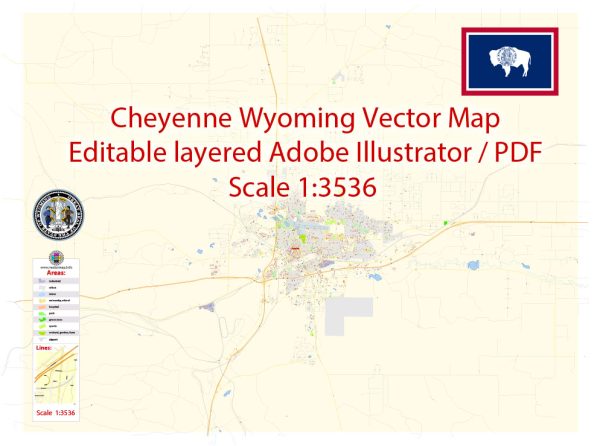Cheyenne, Wyoming, has a rich history of urban development that reflects the broader trends of westward expansion, the railroad boom, and the establishment of frontier settlements. Here is a brief overview of Cheyenne’s history of urban development:
- Early Settlement and Fort Russell: Cheyenne’s history began in the mid-19th century when it was established as a railroad and military outpost. In 1867, Major General Grenville M. Dodge, chief engineer for the Union Pacific Railroad, selected the site for Cheyenne as a point along the transcontinental railroad. The city was named after the Cheyenne Native American tribe. Fort D.A. Russell, later renamed Fort Francis E. Warren, was also established in the area, contributing to the city’s growth.
- Railroad Boom: The arrival of the Union Pacific Railroad in 1867 marked a significant turning point for Cheyenne. The city quickly grew as a major hub for the railroad, attracting settlers, entrepreneurs, and businesses. Cheyenne became a vital stop for trains, and the development of the railroad spurred economic growth and infrastructure expansion.
- Cattle and Agriculture: The late 19th century saw the emergence of the cattle industry in Cheyenne. The city became a key cattle-shipping point, with the famous Cheyenne Depot serving as a central hub for cattle transportation. Agriculture also played a crucial role in the city’s economy, and the development of irrigation systems allowed for increased farming in the region.
- Capital City: Cheyenne was designated as the capital of the Wyoming Territory in 1869, further solidifying its importance. This decision spurred additional growth as government institutions and services were established in the city.
- Architecture and Infrastructure: The late 19th and early 20th centuries saw the construction of many historic buildings in Cheyenne. Notable examples include the Wyoming State Capitol, the Governor’s Mansion, and the Union Pacific Depot. These structures reflect the architectural styles of their respective eras and contribute to Cheyenne’s historic character.
- Military Presence: The military continued to play a role in Cheyenne’s development through the presence of Fort D.A. Russell (later Warren Air Force Base). The base has been a key factor in the city’s economy and development, especially during periods of military expansion.
- Oil and Energy: In the 20th century, the discovery of oil in Wyoming brought economic prosperity to the region, including Cheyenne. The energy sector became a significant driver of the local economy, and the city continued to evolve as an important urban center in the state.
- Modern Development: Cheyenne has continued to grow and modernize, with a focus on preserving its historical character while adapting to the changing needs of the community. The city’s economy diversified, and it became a regional center for business, government, and culture.
Today, Cheyenne remains a blend of its historical roots and contemporary development, offering residents and visitors a glimpse into the history of the American West.


 Author: Kirill Shrayber, Ph.D.
Author: Kirill Shrayber, Ph.D.